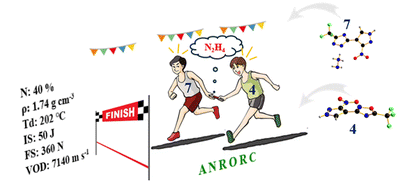
Vikas D. Ghule
Assistant Professor
Department of Chemistry
National Institute of Technology Kurukshetra
Kurukshetra-136119, Haryana, India
Phone: +91-744-233-531 , +91-9896006804
Email: gvd@nitkkr.ac.in or ghule.vikas@gmail.com
ORCID: 0000-0002-0967-7777
Google Scholar: https://scholar.google.com/citations?hl=en&user=ZHqv4o8AAAAJ&view_op=list_works&sortby=pubdate
Research Gate: https://www.researchgate.net/profile/Vikas_Ghule
Research Interest and Expertise
-
High Energy Materials (HEMs)
-
Computational chemistry
-
Organic chemistry
-
Nitrogen-rich heterocycles
-
High Energy Materials (HEMs)
In general, the term “High Energy Materials (HEMs)” was used by the researchers in explosive field for the materials known as explosives, propellants and pyrotechnics. An energetic material is defined as a compound or mixture of substances, which originates their energy from a chemical reaction. Explosives are generally known and related with their destructive role but their overwhelming role in the development and prosperity of mankind right from the time of discovery of black powder are very often lost sight of. One can say - some of today’s fantastic engineering projects and space exploration would have not been imaginable without the use of explosives or propellants. Today, HEMs (explosives, propellants and pyrotechnics) find use in mining, construction, demolition, safety equipment (airbags, signal flares, fire suppression systems, etc.), rocketry and space exploration among other civil and military applications.
Performance, sensitivities, environmental toxicities, and cost of production are important parameters to be considered in the design of new HEMs for practical application. Of all the driving forces in HEMs worldwide, ecological worries are one of the most influential. When developing new secondary explosives, numerous approaches are implemented to achieve the final molecules with high densities and heat of formation (HOF). From the examples of TNT, TATB, RDX, and HMX, we can identify the energetic properties required for current explosives.
A large number of explosives and propellants have been developed and reported in the recent past. The selection of an explosive is made taking into account stability, consistency, safety, and use. The use of CHNO materials (halogen-free) comprising high amounts of oxygen and nitrogen attained by highly nitrated molecules gained more attention since they mostly decompose into eco-friendly gaseous products. Our work has the objective to design CHNO energetic molecules, that combine high performance with less sensitivity. Many ideas have been evolved during the last 70 years of ongoing research in this field. Considerable information is accessible about the performance-boosting chemical building blocks, like nitramines, nitro and nitratester groups, N-N single and double bonds and hydrocarbon backbone as precursors and heterocyclic systems which form products with highly exothermic heats of formation like N2, CO2 and H2O, and more attention is now given to the sensitivity of energetic molecules. The finding or screening of suitable precursors and building blocks for the development of energetic materials is of interest, as well as the understanding of their chemistry.
-
Computational Chemistry
Computational chemistry is a distinct field of chemistry today. Advances in theoretical techniques and in computer power have dramatically increased the usefulness and importance of computational chemistry. Computational chemistry is fairly inexpensive, it is fast compared to experiment, and it is environmentally safe (except consumption of energy and the dumping of old machines). Computational chemistry term used to mean many different things. For example, the use of computers to analyse data obtained in complex experiments. Yet, more commonly this term means the usage of computers to make chemical predictions. Computational chemistry is used to predict new molecules or new reactions which are later explored experimentally. Computational chemistry is also used to supplement experimental work by providing data which are difficult to describe experimentally (e.g. transition states and energies). It commonly used to investigate: molecular geometries, transition states and energies of molecules, chemical reactivity, spectra (IR, UV and NMR), interaction of a substrate with an enzyme, physical properties of substances, and so on.
Computational chemistry doesn’t replace experimental work (one has to go into the laboratory to make new compounds, drugs, materials, etc.), but it helps to simplify assumptions and approximations and tackle complex problems, and influences our understanding for designing more productive and efficient processes, characterizes new compounds, and help researchers extract useful knowledge from huge data.
-
Our Aim: The development of accurate models and simulations of HEMs has been aggressively pursued within energetic material research since the arrival of computational capabilities and various computational chemistry software packages. The high time and costs related to the synthesis, testing, and fielding of a new energetic material led to the need for incorporating modeling into the design process of HEMs. This has led to growing demands for accurate models to calculate properties and behavior of notional energetic materials before committing resources for their development. Predictive and reliable models that will allow for the selection and rejection of poor candidates before spending time and resources on synthesis and testing of advanced materials give major economic benefits in developing a new material. Therefore, great attention has been given to developing computational tools for use in explosives research and has resulted in a dramatic evolution of methods and applications of these to explosives. The capability to calculate the performance of compounds before the laborious and expensive task of synthesizing them is of specific importance in designing new explosives.


Work Experience
-
Assistant Professor (AGP 8000/-), Department of Chemistry, National Institute of Technology Kurukshetra 25.10.2022 - Present
-
Assistant Professor (AGP 7000/-), Department of Chemistry, National Institute of Technology Kurukshetra 09.09.2013 - 24.10.2022
-
Research Associate, ACRHEM, University of Hyderabad, Hyderabad 2012-2013
Education
-
Ph. D. Chemistry from University of Hyderabad, Hyderabad 2007-2012
-
M. Sc. (Masters Degree) Organic Chemistry from University of Pune, Pune 2005-2007
-
B.Sc. (Bachelor Degree) Chemistry from University of Pune, Pune 2002-2005
Latest Publications
Synthesis and Performance Evaluation of Zwitterionic C–N Bonded Triazole-Tetrazole-Based Primary Explosives
J. Org. Chem. 2024, 89, 19, 14038–14049
https://doi.org/10.1021/acs.joc.4c01434

Synthesis of C–C bonded trifluoromethyl-based high-energy density materials via the ANRORC mechanism
Dalton Trans., 2024,53, 15324-15329
https://doi.org/10.1039/D4DT02088J

Elucidation of the influence of trinitro-diazinotriazine isomerism on the energetic properties and stability: Insights from DFT approach
https://doi.org/10.1016/j.comptc.2024.114931
